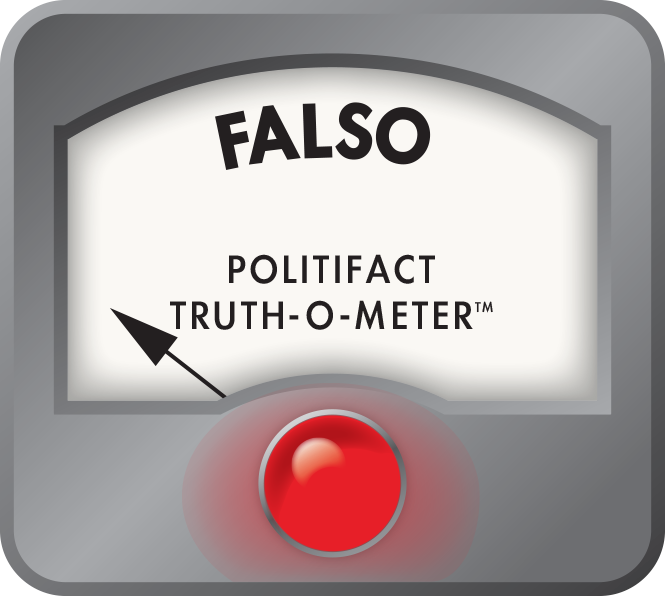Stand up for the facts!
Our only agenda is to publish the truth so you can be an informed participant in democracy.
We need your help.
I would like to contribute
Yes, a school principal tried to ban candy canes
An elementary school principal has been portrayed as a scrooge after multiple news reports and websites said she banned candy canes at her school due to what she said was religious significance.
Several posts on Facebook had a version of this headline: "Principal bans candy canes because the ‘J shape stands for Jesus.’"
This post was flagged as part of Facebook’s efforts to combat false news and misinformation on its News Feed. (Read more about our partnership with Facebook.) In this case, it was accurate that the principal attempted to ban candy canes, but the district reversed her ban.
Leading up to the holiday season, the principal at Manchester Elementary School in Nebraska, Jennifer Sinclair, sent a staff memo outlining rules for the holiday season. Her list included "not acceptable" items or practices for the classroom including Santa or Christmas art on worksheets, Christmas music and books and ornaments.
Then she provided the guidance on candy:
"Candy Cane — that’s Christmas-related. Historically, the shape is a ‘J’ for Jesus. The red is for the blood of Christ, and the white is a symbol of his resurrection. This would also include different colored candy canes."
Sinclair listed several winter symbols as "acceptable" including hot chocolate, snowmen, gingerbread people, and Olaf, the snowman from "Frozen."
She signed the memo as "The (Unintentional) Grinch who stole Christmas (from Manchester)."
The Liberty Counsel, a national conservative Christian organization based in Florida, heard about the memo and fired off a letter Nov. 30 to district? Superintendent Bary Habrock asking him to "disavow the sweeping directive banning Christmas holiday items." The Liberty Counsel included the text of Sinclair’s memo in its letter, which then drew national media attention.
The Liberty Counsel said that the ban showed "hostility toward Christianity" and violated the district’s own policy, which allows teaching about religion. While the district policy doesn’t mention candy canes per se, it does say "Christmas trees, Santa Claus and Easter eggs and bunnies are considered to be secular, seasonal symbols and may be displayed as teaching aids provided they do not disrupt the instructional program for students." (The Anti-Defamation League, a national group that fights against anti-semitism, recommends that if a school has holiday decorations, "they should represent the diversity of the season and should avoid symbols with patently religious meanings to avoid sending the message to students that a religion or a particular denomination is preferred.")
Mat Staver, founder of the Liberty Counsel, told PolitiFact that the school district said Sinclair’s memo was not consistent with district policy.
Featured Fact-check
Principal Sinclair later sent an email to parents apologizing for the staff memo, saying the information she initially provided was incorrect, according to WOWT TV.
Elkhorn school district spokeswoman Kara Perchal told PolitiFact that Sinclair was placed on administrative leave Dec. 6. Sinclair is in her first year at the school district. PolitiFact was unable to reach Sinclair — a person in the school office said she currently has no voicemail or email.
"Dr. Sinclair's memo did state that candy canes could not be used; however, this information was in direct opposition to our district policy regarding holiday symbols in the classroom," she said.
Sinclair ascribed religious significance to the candy cane, from its shape to its red and white stripes.
Our fact-checking friends at Snopes found statements that candy canes were created as Christian symbols representing the blood and purity of Jesus are false. (The original Snopes report was in 2000 and the website updated the story in 2017.)
The National Confectioners Association’s article about the history of candy canes makes no mention of Jesus. It says, according to legend, in 1670 a choirmaster in Germany handed out sugar sticks to his young singers and had the candies bent into shepherds’ crooks. It wasn’t until the turn of the century that the red and white stripes and peppermint flavors became the norm.
The association wrote that In the 1920s, Bob McCormack began making candy canes as Christmas treats. In the 1950s, Bob’s brother-in-law, Gregory Keller, a Catholic priest, invented a machine to automate candy cane production.
Susan Benjamin, author of "Sweet as Sin: The Unwrapped Story of How Candy Became America's Favorite Pleasure," told the Charleston Gazette-Mail in 2015 that there have been various rumors about the origins of candy canes.
But she told the Gazette-Mail that candy canes are not a symbol of Jesus.
"The candy cane is not a ‘J,’ the red is not meant to represent the blood of Jesus," said Benjamin, founder of True Treats Historic Candy, based in Harpers Ferry, W.V.
Several news articles and websites said that a school principal banned candy canes. A principal wrote a memo to staff banning candy canes and said it was a symbol of Jesus. Comments by the school district show that this was no holiday tale.
Ultimately, it's important to know the school quickly reversed the ban. So we rate this Mostly True.
Our Sources
CBS Pittsburgh, "‘The Shape Is A J Is For Jesus’: Principal Bans Candy Canes, Christmas-Related Items From Classrooms," Dec. 9, 2018
Inner strength Zone, "Principal bans candy canes because the ‘J shape stands for Jesus,’" Dec. 9, 2018
Fox2Detroit, "Principal bans candy canes, says "J" shape stands for Jesus," Dec. 8, 2018
Star-Herald (Scottsbluff, Nebraska), "A Nebraska elementary school principal tried to ban Christmas. It didn't go well," Dec. 6, 2018
WOWT TV, "Elkhorn Public Schools addresses internal memo at elementary school banning Christmas decorations," Dec. 5, 2018
Charleston Gazette-Mail, "Historian shares the origin stories of Christmas candy," Dec. 20, 2015
Anti-Defamation League, "The December Dilemma: December Holiday Guidelines for Public School," Accessed Dec. 10, 2018
Snopes, "Did a Principal Ban Candy Canes Because They Are Shaped Like J’s for ‘Jesus’?" Dec. 7, 2018
Snopes, "Did Candy Canes Originate as Religious Symbols?" Dec. 7, 2000 and updated Dec. 10, 2017
Principal Jennifer Sinclair, Memo, November 2018
National Confectioners Association, A Candy Cane Story, Accessed Dec. 10, 2018
History.com, "Who invented candy canes?" Dec. 7, 2018
Liberty Counsel, Letter to Elkorn Public Schools Superintendent Bary Habrock, Nov. 30, 2018
Interview, Mat Staver, Liberty Counsel founder and chairman, Dec. 10, 2018
Interview, Elkhorn school district spokeswoman Kara Perchal, Dec. 10, 2018
Browse the Truth-O-Meter
More by Amy Sherman
Yes, a school principal tried to ban candy canes
Support independent fact-checking.
Become a member!
In a world of wild talk and fake news, help us stand up for the facts.










































